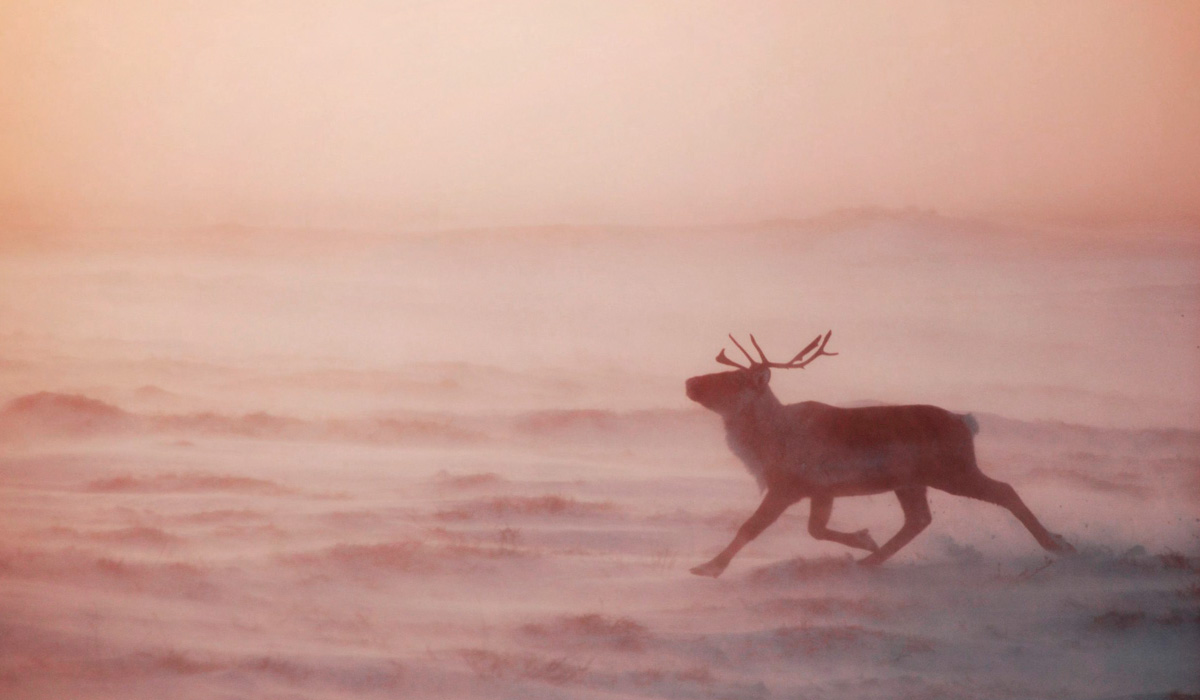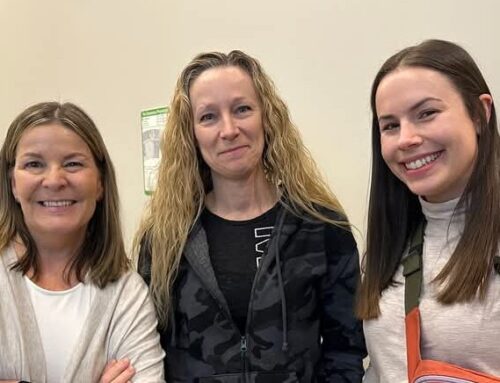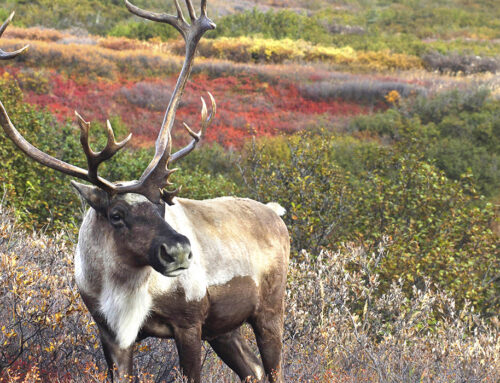TRACKING CHANGE IS KEY TO SUCCESSFUL HERD MANAGEMENT
Everything from plants to animals to humans depends on the land to survive and grow. But these days, the land is changing.
Local hunters of Beverly and Qamanirjuaq herds are noticing fewer cold days in early winter and later freeze-up, as well as more over-flow water on the lakes. Records from the Dubawnt River in Nunavut indicate that between 1968 and 1995, the water stayed open about 50 days longer than before, breaking up earlier in the spring and freezing later in the fall.
Elsewhere, man-made developments like mines, roads and logging are resulting in visible changes to the land. They also trigger more subtle changes. Global warming is bringing startling changes to parts of northern Canada, and scientists predict that this trend will continue. Keeping track of developments that affect Beverly and Qamanirjuaq caribou, their range, and caribou range communities is key to successfully managing the herds, especially in the face of constant change.
Local/traditional knowledge is critical
In May 2000, the BQCMB agreed to create a long-term ongoing monitoring system that uses local/traditional knowledge as well as science. “Considering the high uncertainty of scientific data, a system must be developed to obtain information on the herds from hunters in the communities,” writes former Canadian Wildlife Service biologist and BQCMB member Don Thomas in a recent review of the Board’s operations.
The Beverly and Qamanirjuaq Monitoring Project is co-ordinated by wildlife biologist Leslie Wakelyn, who has worked with the Board since 1996. It is modelled on an earlier system created for the Porcupine caribou herd.
Joe Tetlichi, chairman of the Porcupine Caribou Management Board, says that the monitoring program of the Porcupine range –”The Arctic Borderlands Ecological Knowledge Co-op”– succeeded partly because project organizers began working with the region’s communities long before the project was started, and established a relationship of trust.
Gary Kofinas of the Institute of Arctic Studies, one of the Knowledge Co-op co-ordinators, says this process requires following some simple but important principles: “going slowly, keeping it simple, staying relevant to the needs and concerns of communities, economizing where possible, and thinking long-term.”
The Knowledge Co-op also succeeded, Tetlichi points out, because it gained information from local experts. “We started incorporating traditional and scientific knowledge . . . using what we need, you know, and getting the relationship going.
“It’s important to realize that times are changing,” says Tetlichi. “Our culture is quickly changing. Back in the ’60s and ’70s, people were part of the caribou cycle. They took caribou when they needed it, they left it alone when they didn’t need it. . . . They always knew that the caribou was going to come back.
“But now the caribou has more obstacles with global warming, climate change, industrial developments, highways through their habitat range, more people harvesting caribou,” he says.
BQ project would draw on local resources
People need better ways to share knowledge and discuss the effects of change on the land, caribou, and people who depend on caribou. As well as providing essential information for management of the Beverly and Qamanirjuaq caribou herds, this monitoring project will contribute to a large circumpolar caribou/reindeer monitoring initiative of the Working Group on the Conservation of Arctic Flora and Fauna.
The Beverly and Qamanirjuaq project will be developed over several years, and will draw on resources such as the Tadoule Lake Caribou Traditional Knowledge Project, and the Lutselk’e community monitoring project and caribou body condition monitoring project. It will also draw on the local knowledge database from Nunavut communities on the Beverly and Qamanirjuaq range, part of an effort spearheaded by organizations such as the Nunavut Planning Commission, which has been mapping lands with the help of traditional and local knowledge for some years now. A key part of the project will be communication – an opportunity for community members, researchers, and managers to discuss what is changing and why.
In addition to striving to preserve caribou, the Beverly and Qamanirjuaq monitoring project will hire and train several local residents, and make sure that communities have control of local knowledge. Community representatives on the BQCMB and local organizations will take the lead in identifying people to hire.
Indicators of change
At the Board’s last meeting in November 2000, some “indicators of change” for Beverly and Qamanirjuaq caribou and caribou range were demonstrated on a web site that was created for the BQCMB by Joan Eamer of the Canadian Wildlife Service, with data compiled by Wakelyn.
This type of Internet-based reporting system is one way to distribute information about trends in these and other indicators of change based on data from Beverly and Qamanirjuaq caribou, range, and communities. Written reports, posters, oral presentations and interim project and financial reports will also help provide access to information learned from this project.
Indicators track what is or is not changing on the land. The best indicators are easy to use, can be measured year after year, have past records, and give people meaningful information.
Some examples are human population, caribou population, break-up and freeze-up times of rivers, and levels of human activities (such as air traffic). To get the monitoring program rolling, BQCMB members talked about current conditions at their November meeting, as well as recent changes in caribou distribution and movements, caribou range, hunting opportunities, and caribou health. Information-sharing and discussion such as this could take place regularly as part of the monitoring project.
Money is needed now to start the monitoring project on the ground. BQCMB chairman David Kritterdlik suggested that monitoring in Nunavut begin first in Baker Lake and Arviat, since hunters from Baker Lake harvest from both the Beverly and Qamanirjuaq herds, and Arviat lies near the spring and fall migration routes of the Qamanirjuaq herd. Local project co-ordinators would be hired to canvas up to 40 resident experts in these two Nunavut communities for their observations on caribou-related changes.
The BQCMB will be explaining the project to communities on the range, to ask if they support the idea of community monitoring. Talks are underway to see how monitoring can begin in other parts of the range in Manitoba, Saskatchewan and the Northwest Territories. The Lutselk’e Wildlife, Lands and Environment Committee wants to become involved in the project, and BQCMB member Jimmy Laban of Black Lake says Saskatchewan communities are in favour of community-based monitoring, too.
NO POPULATION SURVEYS YET
Population surveys for the Beverly and Qamanirjuaq herds probably won’t take place now until 2002, following a survey in 2001 of the high-priority Bathurst herd, whose calving grounds lie in the NWT’s rapidly developing diamond mine region.
It was hoped that surveying of the Beverly and Qamanirjuaq animals might go ahead in June 2001 (see Caribou News in Brief, May 2000). In December 2000, BQCMB chairman David Kritterdlik wrote to Nunavut’s Minister of Sustainable Development, Olayuk Akesuk, urging that surveying of the two herds be given priority.
Current information leads the BQCMB to believe that harvest of the Beverly and Qamanirjuaq caribou is close to the sustainable limit. For the past year, the board has refused to recommend on requests for outfitting or commercial quotas referred to it by governments without the benefit of updated survey information.
The Board has traditionally favoured conservative quota recommendations anyway, rather than allowing too many caribou to be killed, says BQCMB member Cam Elliott. The board takes the low end of population estimates as the real indication of herd size. There are a lot of variables when it comes to herd management: not all communities report harvest statistics; wounding losses are only estimated, not measured; governments cannot control the aboriginal harvest of caribou. This, combined with more people living on the range, more hunting, and uncertain survey results, has compelled the BQCMB to adopt a “better safe than sorry” approach on quota recommendations.
Survey method imprecise?
The accuracy of the calving ground photo survey method currently used came into question earlier this year when officials with Nunavut’s Department of Sustainable Development started to rethink the task ahead of them. The calving grounds of both the Beverly and Qamanirjuaq herds fall inside the new territory of Nunavut’s boundaries, and Nunavut was expected to play a lead role in surveying. In recent months, the governments of Manitoba, Saskatchewan and NWT have all pledged to add their financial support as well.
While the photo survey method has been deemed the best course of action to date, some officials began to worry that it wasn’t accurate enough to determine trend, given the size of the large Beverly and Qamanirjuaq herds and the landmass they roam across. Of greatest concern were fairly large “confidence intervals”: the give-or-take figure on either side of the official estimate.
As a result, biologists and statisticians intent on finding a way to make this survey method more reliable before it was used again on the Beverly and Qamanirjuaq herds met for a two-day brainstorming session in Yellowknife in early November. The highly technical session produced a series of recommendations.
Looking for improvements
BQCMB member Mitch Campbell, a biologist with the Department of Sustainable Development, says his department will now do several things: conduct a power analysis on trend data from the last few surveys; put the photos from the last two surveys into digital computer format; and then apply post-stratification methods to see how surveying can be made more precise.
At the BQCMB’s next meeting in June, Campbell says he will be discussing technical changes in the management with board members, and that board members will need to look at the ability of the current surveying method to incorporate these changes. “We need to resolve that as soon as possible.”
DON THOMAS WINS NATIONAL AWARD
Former longtime BQCMB member Don Thomas of Edmonton, Alberta has capped a 40-year career as a Canadian Wildlife Service caribou biologist by winning Indian and Northern Affairs Canada’s prestigious Northern Science Award for 2000.
The $5,000 award, which comes with a silver medal, is presented yearly to an individual or aboriginal group that has helped Canadians better understand the North through their scientific work and past achievements. “Science,” in this case, is anything that helps improve understanding of the natural world and human society. Recent past winners include archeologist Graham Rowley, and the Inullariit Elder’s Society of Igloolik, Nunavut.
In the report Protecting Beverly and Qamanirjuaq Caribou and Caribou Range, BQCMB chairman David Kritterdlik said Thomas “has consistently demonstrated his respect for Aboriginal values and points of view, and has been committed to involving Aboriginal people in his research.”
Fellow biologists were equally warm with their praise after hearing Thomas was in line for the Northern Science Award.
In a Nov. 28, 2000 Edmonton Journal article, renowned polar bear biologist Ian Stirling called Thomas “one of the most respected caribou biologists today. No one deserves this award more than him.
“I think that Don, like Ernie Kuyt, Frank Miller, Richard Harrington and others like them, was representative of an era when scientists in the Canadian Wildlife Service undertook in-depth and long-term research on particular species and became the top experts in the world.
“The value of the research undertaken by such individuals, and the greater recognition by the government in earlier years that long-term work was one of the things required to manage renewable resources to the best of their ability, is something we don’t see enough of today.”
Thomas has been typically modest in light of his latest achievement.
“It was the years of experience gained with the Canadian Wildlife Service, some special projects with the BQ Caribou Management Board, and work with many (colleagues) as well as aboriginal people that resulted in the award,” he said recently.
“The award renews faith in a system where there is no substitute for hard work, long-term co-operative studies, team work, and dedication to conservation goals.”
AROUND THE RANGE
Charity begins at home
The BQCMB, which submitted a bid for charitable status in March 2000, has been approved as a registered charity by Canada Customs and Revenue Agency. Having charitable status has several advantages: it’s easier to request money from foundations for public and conservation education (including caribou monitoring), for collecting and publishing traditional knowledge, for translating Caribou News in Brief articles in Dene and Inuktitut, and similar undertakings.
Search our site
SOS, in this case, is not a distress call. “Search our site” is a call to BQCMB web site visitors to take advantage of a powerful new search function that looks up all PDF files as well as regular HTML pages on the BQCMB’s web site. This nifty new tool ensures visitors catch wind of all the content that’s recently made its way onto the web site, including the BQCMB’s new CD-ROM, Protecting Beverly and Qamanirjuaq Caribou and Caribou Range. Part 2: Map Atlas and Documentation, and satellite collaring location maps of collared Qamanirjuaq caribou. As of December, the BQCMB site had received 9,000 visitors since launching three years earlier, and on Oct. 16, 2000, was picked as the Reader’s Choice by The Ottawa Citizen newspaper.
Newsletter news
How time flies! Caribou News, the predecessor to this newsletter, made its debut exactly two decades ago. Called Keewatin Caribou at the time, the initial four-page October 1980 issue introduced readers to a proposed community relations program on the Beverly and Qamanirjuaq caribou, whose populations were considered by some to be endangered at the time.
Meanwhile, the Keewatin Wildlife Federation and the government of Nunavut’s Department of Sustainable Development have launched a new publication. Kivalliq Wildlife News publishes twice a year (summer and winter), reporting on wildlife concerns, research projects, hunters’ observations, wildlife-related commercial activities, and more. Written contributions are welcome, and can be sent to Kivalliq Wildlife News, c/o Department of Sustainable Development, P.O. Box 120, Arviat NU X0C 0E0.
Caribou workshop
BQCMB chairman David Kritterdlik will attend the 9th North American Caribou Workshop, slated for April 23-27, 2001, in Kuujjuaq in northern Quebec. He’ll have some familiar travelling companions. Both Gary Kofinas, one of the advisors of the current proposed Beverly and Qamanirjuaq Caribou Monitoring Project, and Joe Tetlichi, chairman of the Porcupine Caribou Management Board, will be going, too (Tetlichi is one of five keynote speakers). Kritterdlik, Kofinas and Tetlichi all took part in an international conference on the human role in reindeer/ caribou systems in Finland 1999.
BQCMB meeting
Board members will head to Black Lake, Saskatchewan for their next meeting, June 1-3, 2001. In the fall, it’s off to Yellowknife for the Board’s Nov. 23-25, 2001 assembly.
BQCMB SCHOLARSHIP WINNERS
Winners of the BQCMB’s 2000 Caribou Management Scholarship want to show how harnessing other methods of understanding could improve caribou herd management.
Keri Zittlau, a University of Alberta PhD student, is using miscrosatellite DNA analysis to figure out the herd range boundaries of the Beverly and Qamanirjuaq caribou. Since caribou migrate over huge distances, it’s hard to determine their range boundaries. But it’s important to know where migration routes are so that resource development doesn’t interfere with caribou movements, and so that caribou-dependent northerners know where the animals are.
DNA is the chemical in humans and animals that decides what they will look and be like. Microsatellites are short DNA sequences that reveal extensive genetic differences between individuals and populations. Zittlau is analyzing about 100 samples collected in 1991-1992, and her work should wrap up by late spring, 2002.
University of Manitoba PhD student Anne Kendrick, who received the same award several years ago for her study of the effectiveness of co-management and the BQCMB, is focusing on traditional ecological knowledge this time.
She is already helping the community of Lutselk’e to develop computer-based “talking maps,” with pop-up videos and pictures, to “link land use information with environmental knowledge that people have about the land and about caribou,” says Kendrick.
Now she’ll be talking with local residents to see how they feel about the caribou management process, whether they feel the kind of knowledge they have is being incorporated into management systems, and what their suggestions are for future management. She hopes to publish her thesis by spring 2002.
NUNAVUT, MANITOBA LOOK FOR FEDS’ SUPPORT ON ROAD
If all governments are committed, the next step for an ambitious billion-dollar proposal to run a hydro line and road from Manitoba to Nunavut is further environmental, economic and social impact analyses, including community and interest group consultations.
But at this stage, the federal government is not yet onside with the governments of Nunavut and Manitoba – and the federal government’s support is crucial.
Nunavut and Manitoba share a long-term dream to install a hydro line between Churchill and Rankin Inlet, and a road linking Kivalliq communities to Manitoba, in a bid to lower power and shipping costs for Nunavut, and boost industry and tourism for both jurisdictions.
In late May 2000, Manitoba Highways and Government Services completed a study called Manitoba-Nunavut Transportation Assessment. The latest study strictly firms up the cost range of five possible routes suggested – it doesn’t recommend a particular route.
In early December, Nunavut’s Minister of Community Government and Transportation, Jack Anawak, met with Manitoba’s Minister of Highways and Government Services, Steven Ashton, to “(develop) a means to approach the federal government,” says Manitoba transportation policy consultant Richard Danis. It’s hoped that a joint Nunavut/Manitoba delegation will head to Ottawa to lobby key contacts sometime between January and March, 2001.
Manitoba Dene worried
Ross Thompson of Manitoba’s Intergovernmental Affairs Department gave BQCMB members an update on developments at the Board’s November 2000 meeting in Winnipeg. Thompson and several other Manitoba government officials briefed the BQCMB on the proposed megaproject a year earlier.
BQMCB member Albert Thorassie, repeating earlier concerns, stressed that the prospect of a road worried Dene communities in northern Manitoba because it would open up the area to many more non-resident Treaty Indians who could kill far more caribou.
GOVERNMENTS BACK RENEWED BQCMB MANDATE
The governments of Manitoba, Saskatchewan, NWT and Nunavut have all agreed to extend the BQCMB’s mandate beyond 2002.
“Manitoba Conservation recognizes the Beverly and Qamanirjuaq Caribou Management Board as a necessary and an effective means of co-ordinating caribou management across four provinces and territories,” Conservation Minister Oscar Lathlin wrote to BQCMB chairman David Kritterdlik in July 2000.
“The creation of the Board established a means for the native people, who depend on these caribou for their livelihood, to direct governments on the management of the caribou for the benefit of local Aboriginal people.”
The BQCMB, whose second 10-year mandate ends in June 2002, was formed in 1982 amidst a perceived caribou population crisis. Comprised of eight aboriginal board members and four government board members, the BQCMB continues today as an advisory board to the four governments that jointly oversee the widespread range of the Beverly and Qamanirjuaq caribou.
PEOPLE AND CARIBOU
After four years, BQCMB member Richard Mercredi is moving on. No replacement has been nominated yet for the Métis Nation representative. Mercredi recently became the regional superintendent for the Department of Public Works and Services with the NWT government in Fort Smith, and the added responsibilities will consume much of his time. His informed commentary at the BQCMB table will be missed.
Mercredi’s farewell appearance at the November meeting in Winnipeg coincided with a BQCMB milestone: the Board’s 50th session.
Now that Saskatchewan Environment and Resource Management (SERM) biologist Tim Trottier has returned from a year-long sabbatical, his replacement at the office, biologist Mike Goodyear, has gone home to his native Manitoba to become director of the Churchill Northern Studies Centre. Both Trottier and Goodyear attended BQCMB meetings during Trottier’s year off.
Both BQCMB meetings in 2000 attracted plenty of guest speakers. In attendance at May’s Churchill meeting were Dr. Peter Scott, scientific co-ordinator of the Churchill Northern Studies Centre, polar bear biologist Ian Stirling, Nunavut Wildlife Management Board member Joan Scottie, and SERM’s Paul Maczek and Daryl Jessop, who spoke about the Saskatchewan government’s new approach to firefighting.
Gary Kofinas of the Institute of Arctic Studies at Darmouth College and Leslie Wakelyn, the BQCMB’s caribou monitoring project co-ordinator, took part in November’s Winnipeg meeting as well as the Churchill get-together. In Winnipeg they were joined by Porcupine Caribou Management Board chairman Joe Tetlichi, Canadian Wildlife Service biologist Don Russell, BQCMB alternate members Joe Martin and Pierre Robillard, biologist Anne Gunn and Wildlife, Environment, Parks and Tourism manager (South Slave Region) Sam Ransom, both with the NWT government, Ross Thompson of Manitoba’s Intergovernmental Affairs Department, and a team from Manitoba’s Parks and Natural Areas: Marilyn Peckett, Jan Dewar and Rodger Schroeder. Michelene Manseau of Parks Canada, Anne Kendrick of Lutselk’e and Tim Byers, an observer for the Yellowknives Dene First Nation, rounded out the full house.
Finally, New Zealand student Phil Livyer has been accompanying Lutselk’e hunters on outings to measure caribou body fat – an easy-to-gauge index of body condition. The research, which has been ongoing for a year and a half, will help Livyer create a caribou body-fat form that hunters will fill out themselves.





